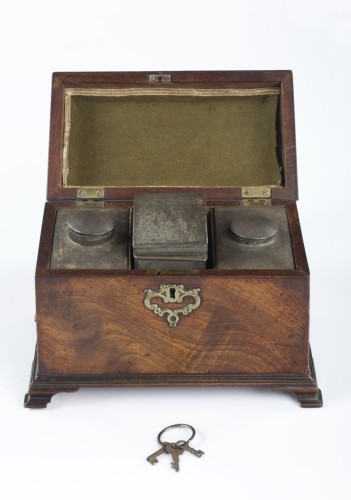38/2008
Collection
Treen
Brief description
Tea caddy made from mahogany, containing three pewter canisters. It has a secret drawer in the base and a brass handle and an escutcheon with three keys. It was manufactured in England c.1740.
Object name
tea caddy
Object number
38/2008
Production date
c.1740 (manufactured)
Production place
England (manufactured)
Period
Georgian (1714-1837)
Material
mahogany
brass
pewter
oak
brass
pewter
oak
Technique
cast
soldered
joined
veneered
soldered
joined
veneered
Physical description
Tea caddy of rectangular form with a coved lid enclosing a compartmented interior with two pewter tea canisters, with circular lids flanking a central pewter sugar canister with a rectangular lid. The caddy has ogee (S- shaped) bracket feet and there is a secret drawer to the base accessed by sliding the panel to the right hand side. It has a brass handle and an escutcheon with keys. The caddy is an oak substrate with a mahogany veneer and has a mitred and nailed construction.
Dimensions
Height: 18.8cm
Width: 25.8cm
Depth: 15.3cm
Depth: 16.3cm
Width: 25.8cm
Depth: 15.3cm
Depth: 16.3cm
Website keywords
tea, coffee and chocolate drinking
Eating, drinking and smoking
serving drink
Eating, drinking and smoking
serving drink
Label
This object was featured in the World at Home project and display at the Geffrye Museum from 17 May to 24 July 2011. The project was a result of a collaboration between the Geffrye Museum and MA students from the Institute of Archeology, University College London. The students chose eleven objects from the museum’s period rooms to highlight the narrative of England’s ever-changing relationship with the rest of the world. Through the expansion of the British Empire and development of international trade, the English middle classes brought into their homes goods as varied as pottery from Germany, tea from China and modern furniture from Scandinavia. Other outputs of the project included design marketing materials, on-line activities, events, design activities for children and visitor and audience research.
The students researched these objects and prepared text panels for the display. The text is recorded below:
Tea’s Travels
Tea was very likely discovered in China, and has been an established drink there for at least 2500 years. In the mid-1600s, tea was brought from the Far East into the ports of London on East India Company ships. The tea was often packed in chests with other goods, such as porcelain and even plants.
A Luxury Commodity
In the beginning of the 1700s, falling prices enabled the consumption of tea to
spread rapidly into most English middling sort homes. Tea was, however, still relatively expensive and heavily taxed – a pound of tea cost the equivalent of a servant’s yearly wage! The lock on the tea caddy prevented servants from stealing the precious tea inside.
A Sociable Drink
In the mid 1700s, tea began to be enjoyed in England as a breakfast drink, as well as being a fashionable refreshment to serve guests. Women of the middling sort hosted sociable tea parties in their homes, displaying their refined manners and exquisite tea sets. Servants placed tea accessories and boiled water on the table, while the lady or gentleman of the house brewed and served the tea.
Showing the correct tea table etiquette was a crucial aspect of the home life of the middling sorts in the 1700s. Because of tea-drinking’s association with elegant manners and wealth, families who commissioned portraits of themselves, often chose to be painted at the tea table.
In England, as well as China, tea was widely thought to have medicinal properties. Although the importance of tea as a sign of social status and fine manners increased throughout the 1700s, tea never quite lost its curative role. Even today many still believe that a nice cup of tea will help to solve any problem!
The students researched these objects and prepared text panels for the display. The text is recorded below:
Tea’s Travels
Tea was very likely discovered in China, and has been an established drink there for at least 2500 years. In the mid-1600s, tea was brought from the Far East into the ports of London on East India Company ships. The tea was often packed in chests with other goods, such as porcelain and even plants.
A Luxury Commodity
In the beginning of the 1700s, falling prices enabled the consumption of tea to
spread rapidly into most English middling sort homes. Tea was, however, still relatively expensive and heavily taxed – a pound of tea cost the equivalent of a servant’s yearly wage! The lock on the tea caddy prevented servants from stealing the precious tea inside.
A Sociable Drink
In the mid 1700s, tea began to be enjoyed in England as a breakfast drink, as well as being a fashionable refreshment to serve guests. Women of the middling sort hosted sociable tea parties in their homes, displaying their refined manners and exquisite tea sets. Servants placed tea accessories and boiled water on the table, while the lady or gentleman of the house brewed and served the tea.
Showing the correct tea table etiquette was a crucial aspect of the home life of the middling sorts in the 1700s. Because of tea-drinking’s association with elegant manners and wealth, families who commissioned portraits of themselves, often chose to be painted at the tea table.
In England, as well as China, tea was widely thought to have medicinal properties. Although the importance of tea as a sign of social status and fine manners increased throughout the 1700s, tea never quite lost its curative role. Even today many still believe that a nice cup of tea will help to solve any problem!








